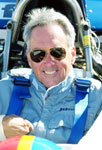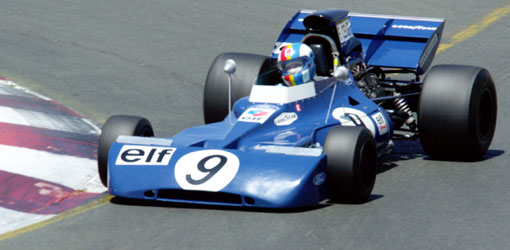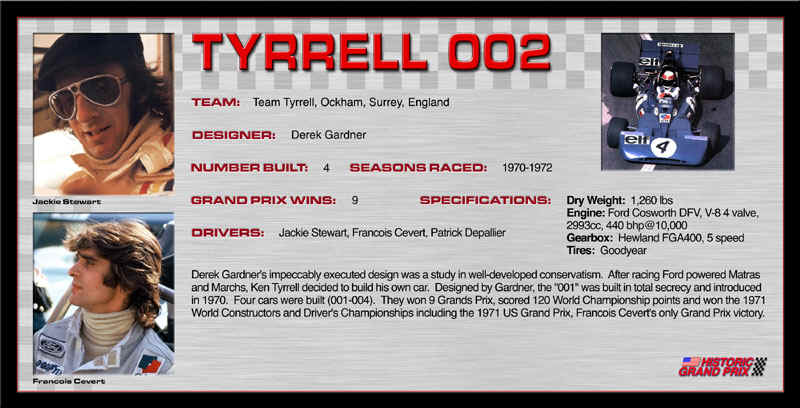When
John Delane is racing, you can almost see the huge grin through his
balaclava. I get a tremendous charge out of
driving well," says John. "And if I have driven well and had a really
good time, whether I fought it out for 15th place or maybe won, maybe
didn't, that is what gives me the charge. If I've driven badly, and
there was nobody to race with, I can still get a kick out of driving
the cars because I just love the pure joy of getting the chance to do
it. But at the end of the day, the real hoot is a hard fought race
with somebody. (HMSA's manager) Cris Vandagriff talks about measuring
the success of the event by the size of the smiles of the drivers
coming off the track. Well, as you say, nobody has a bigger smile than
me, because the sheer joy of being able to get out and play with the
cars is just magic. There's no other way to describe it."
The
first race Delane saw made a significant impact -- it was the 1961 24
hours of Le Mans, while his family was living in France. "A major and
his wife living nearby offered me a ride in the back of a 356 Porsche
to go the 90 kilometers up the road to Le Mans for the 24 hour race.
They slept in a tent and I slept in the driver's seat of the Porsche
with the seat reclined. And like all Le Mans weekends, it rained off
and on. I slogged through the rain carrying my Brownie 8 millimeter
movie camera and stood on the wall. I watched Stirling Moss run across
the track and jump into Rob Walker's dark, dark
blue-with-the-white-band-on-the-nose short wheelbase 250GT Ferrari and
never got over it." Today, Delane's two Lotuses are painted in Rob
Walker colors -- he has a 26R and a '59 Lotus 18 Formula Junior (driven
by Innes Ireland, Denise McCluggage, and Jim Hall).
Of the Lotus 18, Delane says, "I'm commemorating Stirling Moss's car
that won the Monaco race in '60 and '61."
Motion is in
Delane's blood. His father was an Army Air Corps fighter pilot who
became a government contractor and moved the family all over the
country, as well as France and Turkey. Delane went to grade school in
six different states and high school in three different countries; he
and his two brothers were all born in different states.
Delane was
bitten by the car bug in junior high back in the late 1950's. "Even
though I was only 12 or13 years old, I participated in cruise nights
up and down the main drag of beautiful Santa Maria, California. From
high school to the drive-in and back to the high school was our route.
I was the classic kid-with-the-Road & Track-hidden-in-the-notebook
in the back of class, paying absolutely no attention to what was going
on. Pontoon Testarossas were what I sketched in my part-time life, and
I read and absorbed everything that was feasible on the subject."
Delane's
love of photography was entwined with the racing. As a college student
in California, he'd hang over the fence at Riverside International
Raceway with his camera craning for a shot of his heroes zooming past. “I
spent time at Riverside, the dry lakes, anywhere I could watch.” Delane remembers sneaking into the pits at the ’65 Times Grand Prix and
rubbing elbows with greats like Jimmy Clark, A.J. Foyt, Dan Gurney,
and Bruce McLaren. And
he still has the pictures to prove it. (Several years ago, Delane won VARA's photography award for his contributions
to the club's Vintage Voice
magazine.) A few years down the road,
he took up autocrossing with the Pacific Sports Car Club in his first
car, a TR3. When he married Mimi, and started a family, Delane
eschewed the requisite wood paneled station wagon and squeezed
everyone into a Lotus Elan (which he also slalomed) and an MGTD.
Meanwhile,
Delane was following in his father's footsteps in contract services.
While attaining his B.A. in political science at Seattle University,
Delane managed contract services for the university and in the
summers, worked for his father at the Tumpane Company, sweeping
floors, toting sheetrock and basically learning the business from the
ground up. In 1977, Delane
and his father Ed Delane, along with Fred Jensen, founded
Del-Jen,
Inc., a government contracting services business. Del-Jen performs
services across the country as diverse as maintaining the housing,
grounds, and infrastructure at military bases, to operating a swing
bridge across the Mississippi River at Rock Island Arsenal, to running
Job Corps Centers (training for disadvantaged youth). Del-Jen has
expanded into a multi-million dollar company, with operations in 33
states and 1,300 employees.
Delane says
his two daughters eventually became "sort of participants in the
racing adventure." In 1984, when his oldest daughter Megan graduated
high school, Delane recalls, "We gave her the choice of a graduation
gift: a trip to Hawaii with her buddies, a new wardrobe for college,
or a racing school with her father, and she opted for three days at
Jim Russell in Formula Fords at Riverside. I'd never done any racing
per se, only having done parking lot type events, time trial type
events, and so this was my first real taste of wheel-to-wheel racing.
My daughter never raced again after that, but I was hooked
completely."
Soon
after, Delane appropriated his younger daughter Colleen's MGB (a 16th
birthday gift) to warm over the motor, install a rollbar, and race on
weekends. Delane's first race was a VARA event at Riverside in spring
of 1986. "I was locked in a hard fought battle for dead last in the G
Production group against a friend's XKE roadster that was absolutely
street bog stock, not even a rollbar... I got completely hooked."
Delane's youngest, son Ryan, became his pit crew. That started the
road towards another, more race prepared MGB built up from a "derelict
rust bucket," the Lotus Formula Jr., a '75 Lola T-400 Formula 5000
(formerly driven by Al Unser, Sr. and Mario Andretti), an ex-Piko
Troberg Brabham BT 18 Formula B (winner of three European Formula 2
races in 1965), and a '64 Lotus 26R (Gil Nickel's old car, developed by Lotus guru
Dave Vegher).
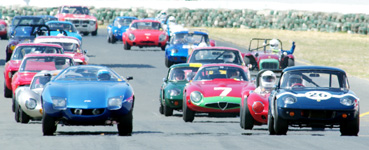 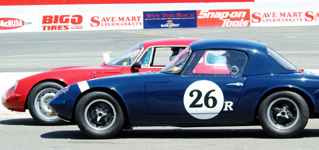
The Dave Vegher prepped
Lotus 26R at the 2001 Wine Country Classic at Sears Point.
"I really got the 26R because I wanted a car I could take my
grandchildren in for rides at lunchtime because it's got a second
seat. On average, though, my focus has always been on the single seaters," says John.
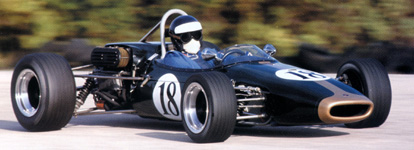
John in his Brabham BT18
Formula B ex-Piko Troberg ride.
People often ask Delane
which is his favorite car. "I've currently got four cars -- Mimi says
I'm one over my limit. It's in many respects asking, 'Well, which kid
do you like better?' You can't say which of your children you prefer
because in fact, you love them all equally. Well, I happen to love all
the cars. The ones I sold, in some respects, I love just as much as
the ones I still have. In many respects I regret I sold anything
through the years, but at the end of the day, it's a reasonable
compromise because nobody needs 20 or 30 cars. I enjoy all my cars. I
get a chance to drive them all and that's pretty great."
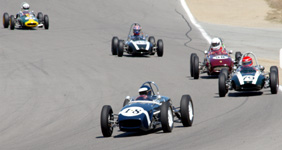 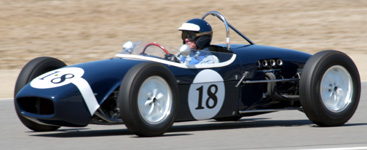
John Delane in his Lotus 18 Formula Junior at the 2001
Monterey Historics.
"A lot of people would
assume the Formula One Tyrrell's got to be more fun than the Lotus 18
and I say, 'Well, there's days when it is. But there are other days
when the Lotus 18 is more fun than the Formula One Tyrrell.' Why is
that? The answer is if I've got a good friend like Mark Nichols in his
Kieft. We can run elbow to elbow for 15, 20 laps and just absolutely
thrash back and forth and have a really great time. It's every bit as
rewarding as going out and having a stunning battle with somebody in
the Formula One car."
Delane has
raced all over the country, winning a few VARA championships
(including an overall points championship) and was on the VARA board
for four years (three of them as treasurer). He instructed at VARA
driving schools and Drive Safe school in his spare time. Delane has
also volunteered with CART for the last 10 to 12 years to do timing
and scoring for the Long Beach Grand Prix and a number of other races
around the country, "mostly as an excuse to get out on the wall to
have a credential," says Delane. "I would lunge out on the wall to
take pictures because I also love to take pictures." Each timer is
assigned a car which they time all weekend. There are redundant
computer systems -- the manual timer feeds into one computer, the
transponders on the car feed into another and the combination of the
two is what the timing and scoring people use to make sure they have
accurate results.
When the 1971
Tyrrell Formula One came up for sale four years ago, Delane had no
choice in the matter -- after all, it matched Jackie Stewart's Tyrrell
on the poster that he acquired at the Italian Grand Prix at Monza. "I
have had that hanging on my wall in my den, my office, my garage, and
my son's bedroom lo these many years and finally got the chance to
acquire the car."
Delane's car is chassis #002, the sister car to
Stewart's chassis #003 (which he still owns and keeps in the Donington
Museum after promising Ken Tyrrell that he would never sell or race
it). Ken Tyrrell's family still owns chassis #001 and fellow Historic
Grand Prix member John Dimmer owns chassis #004.
Of the difference
between his and Stewart's car, Delane says, "While they're not exactly
identical, they are very close in appearance. There is a difference in
wheelbase length on Jackie's car in that he tried an even shorter
wheelbase than is on my car. He had been driving a factory Matra and a
factory March up until Ken Tyrrell decided to build his own chassis.
The first chassis they built was essentially about the same wheelbase
as the March and Matra, maybe slightly shorter. Jackie wanted a
shorter wheelbase because he felt it would be more nimble, something
that his driving skills could match the capabilities of."
Stewart's
successes in Tyrrell #001 inspired them to build the first factory
Tyrrell (Delane's #002) for Francoise Cevert, which had the same
wheelbase as #001. But when it was #003's turn to be built,
specifically for Stewart, he asked that it be four inches shorter. "It
turns out that it was even too short for Jackie. The difficulty with
the short wheelbase is the car wants to spin at the drop of a hat. So
they found the limits on that side of it as well. They had to put a
spacer in between the chassis and the tub and the engine in order to
make it driveable, because even Jackie couldn't keep up with it."
Even with four
inches more of chassis, Delane admits it's not an easy car to drive,
but he likes the challenge. "We've been fortunate to have had some
help with the set-up, and between John Dimmer's car and mine we're
both experimenting with set-up to make the cars a little quicker.
We've both toyed with the idea that if we take the cars to Europe, we
should get Derek Gardner, who designed the car, to give us a hint with
the set-up and see what he can do to improve it even further. But
they're fun, fun cars to drive. It's a great, great hoot to drive,
having that much horsepower and that nimble a chassis."
Going from the
Formula 5000 to the Tyrrell, Delane found that while his Formula 5000
and the Tyrrell both dynoed at 500 horsepower, the delivery of the
power and the handling was like night and day. "What I discovered is
that there is a world of difference between the Tyrrell and the
Formula 5000 in that the 5000 is wider, has a much, much longer
wheelbase and therefore is not so prone to spin. I characterize the
Lola as sort of like trying to muscle an old 60's muscle car around a
road course whereas the Tyrrell is like a Porsche that's very nimble
but changes directions, you know, just really slick. But you have to
keep the Tyrrell revved up like a Porsche in order to get any kind of
performance out of it. The fuel injected motor in the Tyrrell does not
respond well to partial throttle, whereas the fuel injected motor in
the Lola's Chevy small block is perfectly happy to run at very, very
low RPM. You use torque to get it off the corner, whereas the Formula
One four-cam motor has to be revved -- anything below 7,000 and it
just doesn't want to pull at all. Dimensionally, the Tyrrell is closer
to a Formula B car in dimensions and in fact drives more like a
Formula B car on steroids. Typically, a B car has 175 horsepower --
this thing with 500 horsepower is a whole different game."
A
year ago, John Delane lent moral support to fellow HGP member John
Dimmer's purchase of Tyrrell chassis #004 at the Christies Auction at
Monterey. Shortly thereafter, the two decided to recreate
Team
Tyrrell. " It
was really John Dimmer's idea as much as mine. We came up with the
idea about the same time when he was just sort of brainstorming buying
chassis 004. He approached me when he was aware of the fact that it
was going to come up for auction at Monterey and suggested that he was
serious about buying it. He wanted to see if I would be amenable to
assisting him in doing the research on buying it, and if he did buy
it, was I amenable to having some sort of a combined effort on
recreating the Team Tyrrell concept. So I really have to give credit
to him. He's certainly done the vast majority of the legwork to get it
pulled together." It was Delane's friend, graphic artist Edmond
Stoops, who designed the matching suits. He also worked all of the
graphics on Dimmer's car to match Delane's perfectly.
Delane has
been with Historic Grand Prix from its inception. "It's great from the
standpoint that you know all of the participants. You know kind of
what to expect. We've had very, very few squirrels participate with us
in HGP and that's one of the real attractions of it. People who want
to go really, really fast and hang it out all the time can do that as
long as they do it within their own limits. Those who would prefer a
more sedate pace are comfortable doing that. Every now and again I
like to ratchet it up and try a little harder and beat some faster
cars, and there are other times when I'm perfectly content to sort of
run as a show filler and be comfortable and that's all there is on a
given day."
For
Delane, business, racing and family are inextricably linked. His wife,
two children and two sons-in-law work at Del-Jen.
Members of his
family are also involved in racing -- son Ryan has accompanied Delane
to racing school in France and last season, Ryan raced Delane's Lotus
18 in three events. Ryan recently returned from a year and a half
internship with German racing photographer Rainer Schlegelmilch and is
under contract to LAT, Europe's big racing photography house.
Delane's eight year old grandson Tony (he's up to five grandchildren
now) is an accomplished go-kart racer. Delane occasionally treats
employees to go-kart racing days at Perris Lake and also often
invites employees out for race weekends. "I
took the car out for the inaugural event at the Fontana road course
and had a group of employees and families come out. We let the kids
sit in the car and get their picture taken and watch the races. We
make it into a family type of affair."
For Delane, vintage racing
is the realization of a dream begun long ago. "If you go back to my
boyhood days of watching Stirling Moss, now I can go pretend to be
Stirling Moss. It's an opportunity to do something I've always wanted
to since I was very young and at the same time, find an outlet for my
energies that is a whole lot cheaper than having to go to the
emergency room once a week from pounding my head against the wall
dealing with the government."
But it's not just the cars that draw him back. "At the same time, it's
the luxury of a venue where you get to know some of the nicest people in
the universe, which is a by-product advantage that I didn't anticipate
when I started. In many respects the cars were the bait, if you will.
The hook is the marvelous people we've gotten to know over the years."
|


